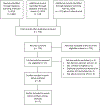D-mannose vs other agents for recurrent urinary tract infection prevention in adult women: a systematic review and meta-analysis
- PMID: 32497610
- PMCID: PMC7395894
- DOI: 10.1016/j.ajog.2020.05.048
D-mannose vs other agents for recurrent urinary tract infection prevention in adult women: a systematic review and meta-analysis
Abstract
Objective: We performed a systematic review and meta-analysis to determine whether D-mannose reduces urinary tract infection recurrence (ie, cumulative incidence) in adult women with recurrent urinary tract infection compared with other prevention agents. Secondary outcomes included side effects and compliance with D-mannose use.
Data sources: Ovid Medline 1946-, Embase 1947-, Scopus 1823-, Cochrane Library, Web of Science 1900-, and ClinicalTrials.gov were searched through 4/15/2020.
Study eligibility criteria: Systematic review inclusion: randomized controlled trials, prospective cohorts, and retrospective cohorts written in English of women ≥18 years old with recurrent urinary tract infection in which D-mannose was utilized as an outpatient prevention regimen. Systematic review exclusion: lab or animal-based research, study protocols only, and conference abstracts. Meta-analysis inclusion: stated D-mannose dose, follow-up time ≥6 months, a comparison arm to D-mannose, and data available from women ≥18 years of age.
Study appraisal and synthesis methods: Two independent reviewers made abstract, full text, and data extraction decisions. Study methodologic quality was assessed using the Cochrane Risk of Bias tool. Relative risks, confidence intervals, and heterogeneity were computed.
Results: Searches identified 776 unique citations. Eight publications met eligibility: 2 using D-mannose only; 6 using D-mannose combined with another treatment. Seven studies were prospective: 2 randomized controlled trials, 1 randomized cross-over trial, and 4 prospective cohort studies. One retrospective cohort study was included. Three studies met meta-analysis eligibility (1 randomized controlled trial, 1 randomized cross-over trial, and 1 prospective cohort). Pooled relative risk of urinary tract infection recurrence comparing D-mannose to placebo was 0.23 (95% confidence interval, 0.14-0.37; heterogeneity=0%; D-mannose n=125, placebo n=123). Pooled relative risk of urinary tract infection recurrence comparing D-mannose to preventative antibiotics was 0.39 (95% confidence interval, 0.12-1.25; heterogeneity=88%; D-mannose n=163, antibiotics n=163). Adverse side effects were reported in 2 studies assessing D-mannose only (1 study (n=10) reported none; the other reported a low incidence (8/103 participants) of diarrhea). Two studies reported compliance, which was high.
Conclusion: D-mannose appears protective for recurrent urinary tract infection (vs placebo) with possibly similar effectiveness as antibiotics. Overall, D-mannose appears well tolerated with minimal side effects-only a small percentage experiencing diarrhea. Meta-analysis interpretation must consider the small number of studies with varied study design and quality and the overall small sample size.
Keywords: D-mannose; UTI; nonantibiotic; nutraceutical; prevention; recurrent urinary tract infection; urinary tract infection.
Copyright © 2020 Elsevier Inc. All rights reserved.
Conflict of interest statement
Figures
References
-
- American College of O, Gynecologists. ACOG Practice Bulletin No. 91: Treatment of urinary tract infections in nonpregnant women. Obstet Gynecol. 2008;111(3):785–794. - PubMed
-
- Foxman B. The epidemiology of urinary tract infection. Nat Rev Urol. 2010;7(12):653–660. - PubMed
-
- Ciani O, Grassi D, Tarricone R. An economic perspective on urinary tract infection: the “costs of resignation”. Clin Drug Investig. 2013;33(4):255–261. - PubMed
Publication types
MeSH terms
Substances
Grants and funding
LinkOut - more resources
Full Text Sources
Other Literature Sources
Medical
Miscellaneous




